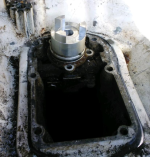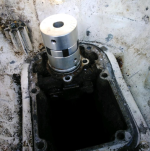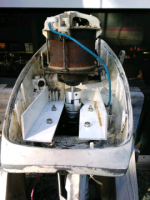If you have feelings about going GREEN, read this. It sheds new light on the cost of batteries on your pocket as well as the environment. Interesting take on the "embedded cost" of EV batteries and all batteries for that matter.
I for one don't believe electric cars and trucks are the way to go.
MH
I am not a chemist, nor do I know if all the stated information is true, BUT some of the narrative does make one think about the worlds push for the electric vehicles, solar panels and wind turbines. I find it to be a clever way of presenting information that needs to be heard.
MH
The Shocking Naked Truth
Bruce Haedrich
When I saw the title of this lecture, especially with the picture of the scantily clad model, I couldn’t resist attending. The packed auditorium was abuzz with questions about the address; nobody seemed to know what to expect. The only hint was a large aluminum block sitting on a sturdy table on the stage.
When the crowd settled down, a scholarly-looking man walked out and put his hand on the shiny block, “Good evening,” he said, “I am here to introduce NMC532-X,” and he patted the block, “we call him NM for short,” and the man smiled proudly. “NM is a typical electric vehicle (EV) car battery in every way except one; we programmed him to send signals of the internal movements of his electrons when charging, discharging, and in several other conditions. We wanted to know what it feels like to be a battery. We don’t know how it happened, but NM began to talk after we downloaded the program.
Despite this ability, we put him in a car for a year and then asked him if he’d like to do presentations about batteries. He readily agreed on the condition he could say whatever he wanted. We thought that was fine, and so, without further ado, I’ll turn the floor over to NM,” the man turned and walked off the stage.
“Good evening,” NM said. He had a slightly affected accent, and when he spoke, he lit up in different colors. “That cheeky woman on the marquee was my idea,” he said. “Were she not there, along with ‘naked’ in the title, I’d likely be speaking to an empty auditorium! I also had them add ‘shocking’ because it’s a favorite word amongst us batteries.” He flashed a light blue color as he laughed.
“Sorry,” NM giggled then continued, “three days ago, at the start of my last lecture, three people walked out. I suppose they were disappointed there would be no dancing girls. But here is what I noticed about them. One was wearing a battery-powered hearing aid, one tapped on his battery-powered cell phone as he left, and a third got into his car, which would not start without a battery. So I’d like you to think about your day for a moment; how many batteries do you rely on?”
He paused for a full minute which gave us time to count our batteries. Then he went on, “Now, it is not elementary to ask, ‘what is a battery?’ I think Tesla said it best when they called us Energy Storage Systems. That’s important. We do not make electricity – we store electricity produced elsewhere, primarily by coal, uranium, natural gas-powered plants, or diesel-fueled generators. So to say an EV is a zero-emission vehicle is not at all valid. Also, since forty percent of the electricity generated in the U.S. is from coal-fired plants, it follows that forty percent of the EVs on the road are coal-powered, n’est-ce pas?”
He flashed blue again. “Einstein’s formula, E=MC2, tells us it takes the same amount of energy to move a five thousand pound gasoline-driven automobile a mile as it does an electric one. The only question again is what produces the power? To reiterate, it does not come from the battery; the battery is only the storage device, like a gas tank in a car.”
He lit up red when he said that, and I sensed he was smiling. Then he continued in blue and orange. “Mr. Elkay introduced me as NMC532. If I were the battery from your computer mouse, Elkay would introduce me as double-A, if from your cell phone as CR2032, and so on. We batteries all have the same name depending on our design. By the way, the ‘X’ in my name stands for ‘experimental.’
There are two orders of batteries, rechargeable, and single-use. The most common single-use batteries are A, AA, AAA, C, D. 9V, and lantern types. Those dry-cell species use zinc, manganese, lithium, silver oxide, or zinc and carbon to store electricity chemically. Please note they all contain toxic, heavy metals.
Rechargeable batteries only differ in their internal materials, usually lithium-ion, nickel-metal oxide, and nickel-cadmium.
The United States uses three billion of these two battery types a year, and most are not recycled; they end up in landfills. California is the only state which requires all batteries be recycled. If you throw your small, used batteries in the trash, here is what happens to them.
All batteries are self-discharging. That means even when not in use, they leak tiny amounts of energy. You have likely ruined a flashlight or two from an old ruptured battery. When a battery runs down and can no longer power a toy or light, you think of it as dead; well, it is not. It continues to leak small amounts of electricity. As the chemicals inside it run out, pressure builds inside the battery’s metal casing, and eventually, it cracks. The metals left inside then ooze out. The ooze in your ruined flashlight is toxic, and so is the ooze that will inevitably leak from every battery in a landfill. All batteries eventually rupture; it just takes rechargeable batteries longer to end up in the landfill.
In addition to dry cell batteries, there are also wet cell ones used in automobiles, boats, and motorcycles. The good thing about those is, ninety percent of them are recycled. Unfortunately, we do not yet know how to recycle batteries like me or care to dispose of single-use ones properly.
But that is not half of it. For those of you excited about electric cars and a green revolution, I want you to take a closer look at batteries and also windmills and solar panels. These three technologies share what we call environmentally destructive embedded costs.”
NM got redder as he spoke. “Everything manufactured has two costs associated with it, embedded costs and operating costs. I will explain embedded costs using a can of baked beans as my subject.
In this scenario, baked beans are on sale, so you jump in your car and head for the grocery store. Sure enough, there they are on the shelf for $1.75 a can. As you head to the checkout, you begin to think about the embedded costs in the can of beans.
The first cost is the diesel fuel the farmer used to plow the field, till the ground, harvest the beans, and transport them to the food processor. Not only is his diesel fuel an embedded cost, so are the costs to build the tractors, combines, and trucks. In addition, the farmer might use a nitrogen fertilizer made from natural gas.
Next is the energy costs of cooking the beans, heating the building, transporting the workers, and paying for the vast amounts of electricity used to run the plant. The steel can holding the beans is also an embedded cost. Making the steel can requires mining taconite, shipping it by boat, extracting the iron, placing it in a coal-fired blast furnace, and adding carbon. Then it’s back on another truck to take the beans to the grocery store. Finally, add in the cost of the gasoline for your car.

























